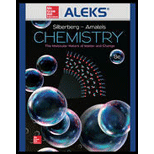
Concept explainers
(a)
Interpretation:
Strong or weak acid or base has to be classified for the given
Concept introduction:
Increasing acid strength:
Acids strength is mainly depending on the dissociation of ions, strong acids dissociates completely and weak acid dissociate slightly.
The hydrohalic acids are strong acids (
Oxoacids are strong acid when the number of oxygen excess than the ionizable proton by two or more oxygen atom for example,
The hydrogen atom which is not bonded to halogen atom or oxygen atoms are weak acid for example
The number of protons is equal to number oxygen in Oxoacids are weak acid for example
The acid strength is depending on the
Increasing base strength:
The base soluble in water and it contains
Weak bases are
(b)
Interpretation:
Strong or weak acid or base has to be classified for the given
Concept introduction:
Increasing acid strength:
Acids strength is mainly depending on the dissociation of ions, strong acids dissociates completely and weak acid dissociate slightly.
The hydrohalic acids are strong acids (
Oxoacids are strong acid when the number of oxygen excess than the ionizable proton by two or more oxygen atom for example,
The hydrogen atom which is not bonded to halogen atom or oxygen atoms are weak acid for example
The number of protons is equal to number oxygen in Oxoacids are weak acid for example
The acid strength is depending on the
Increasing base strength:
The base soluble in water and it contains
Weak bases are
(c)
Interpretation:
Strong or weak acid or base has to be classified for the given
Concept introduction:
Increasing acid strength:
Acids strength is mainly depending on the dissociation of ions, strong acids dissociates completely and weak acid dissociate slightly.
The hydrohalic acids are strong acids (
Oxoacids are strong acid when the number of oxygen excess than the ionizable proton by two or more oxygen atom for example,
The hydrogen atom which is not bonded to halogen atom or oxygen atoms are weak acid for example
The number of protons is equal to number oxygen in Oxoacids are weak acid for example
The acid strength is depending on the
Increasing base strength:
The base soluble in water and it contains
Weak bases are
(d)
Interpretation:
Strong or weak acid or base has to be classified for the given
Concept introduction:
Increasing acid strength:
Acids strength is mainly depending on the dissociation of ions, strong acids dissociates completely and weak acid dissociate slightly.
The hydrohalic acids are strong acids (
Oxoacids are strong acid when the number of oxygen excess than the ionizable proton by two or more oxygen atom for example,
The hydrogen atom which is not bonded to halogen atom or oxygen atoms are weak acid for example
The number of protons is equal to number oxygen in Oxoacids are weak acid for example
The acid strength is depending on the
Increasing base strength:
The base soluble in water and it contains
Weak bases are
Want to see the full answer?
Check out a sample textbook solution
Chapter 18 Solutions
CHEMISTRY:MOLECULAR NATURE...-ALEKS 360
- The quantum yield of the photochemical decay of HI is 2. Calculating the moles of HI per kJ of radiant energy can be decayed knowing that the energy absorbed per mole of photons is 490 kJ.arrow_forwardThe quantum yield of the photochemical decay of HI is 2. Calculate the number of Einsteins absorbed per mole knowing that the energy absorbed per mole of photons is 490 kJ.arrow_forwardThe quantum yield of the photochemical decay of HI is 2. How many moles of HI per kJ of radiant energy can be decayed knowing that the energy absorbed per mole of photons is 490 kJ.arrow_forward
- If the energy absorbed per mole of photons is 450 kJ, the number of Einsteins absorbed per 1 mole.arrow_forwardWhen propionic aldehyde in vapor form at 200 mmHg and 30°C is irradiated with radiation of wavelength 302 nm, the quantum yield with respect to the formation of CO is 0.54. If the intensity of the incident radiation is 1.5x10-3 W, find the rate of formation of CO.arrow_forwardDraw mechanismarrow_forward
- Does Avogadro's number have units?arrow_forwardExplain why the total E in an Einstein depends on the frequency or wavelength of the light.arrow_forwardIf the dissociation energy of one mole of O2 is 5.17 eV, determine the wavelength that must be used to dissociate it with electromagnetic radiation. Indicate how many Einstein's of this radiation are needed to dissociate 1 liter of O2 at 25°C and 1 atm of pressure.Data: 1 eV = 96485 kJ mol-1; R = 0.082 atm L K-1; c = 2.998x108 m s-1; h = 6.626x10-34 J s; NA = 6.022x 1023 mol-1arrow_forward
- Indicate the number of Einsteins that are equivalent to 550 kJ mol⁻¹ of absorbed energy (wavelength 475 nm).arrow_forwardIndicate the number of einsteins that are equivalent to 550 kJ mol⁻¹ of absorbed energy?arrow_forwardA unit used in photochemistry is the einstein. If 400 kJ mol-1 of energy has been absorbed, how many einsteins is this equivalent to?arrow_forward
 ChemistryChemistryISBN:9781305957404Author:Steven S. Zumdahl, Susan A. Zumdahl, Donald J. DeCostePublisher:Cengage Learning
ChemistryChemistryISBN:9781305957404Author:Steven S. Zumdahl, Susan A. Zumdahl, Donald J. DeCostePublisher:Cengage Learning ChemistryChemistryISBN:9781259911156Author:Raymond Chang Dr., Jason Overby ProfessorPublisher:McGraw-Hill Education
ChemistryChemistryISBN:9781259911156Author:Raymond Chang Dr., Jason Overby ProfessorPublisher:McGraw-Hill Education Principles of Instrumental AnalysisChemistryISBN:9781305577213Author:Douglas A. Skoog, F. James Holler, Stanley R. CrouchPublisher:Cengage Learning
Principles of Instrumental AnalysisChemistryISBN:9781305577213Author:Douglas A. Skoog, F. James Holler, Stanley R. CrouchPublisher:Cengage Learning Organic ChemistryChemistryISBN:9780078021558Author:Janice Gorzynski Smith Dr.Publisher:McGraw-Hill Education
Organic ChemistryChemistryISBN:9780078021558Author:Janice Gorzynski Smith Dr.Publisher:McGraw-Hill Education Chemistry: Principles and ReactionsChemistryISBN:9781305079373Author:William L. Masterton, Cecile N. HurleyPublisher:Cengage Learning
Chemistry: Principles and ReactionsChemistryISBN:9781305079373Author:William L. Masterton, Cecile N. HurleyPublisher:Cengage Learning Elementary Principles of Chemical Processes, Bind...ChemistryISBN:9781118431221Author:Richard M. Felder, Ronald W. Rousseau, Lisa G. BullardPublisher:WILEY
Elementary Principles of Chemical Processes, Bind...ChemistryISBN:9781118431221Author:Richard M. Felder, Ronald W. Rousseau, Lisa G. BullardPublisher:WILEY





